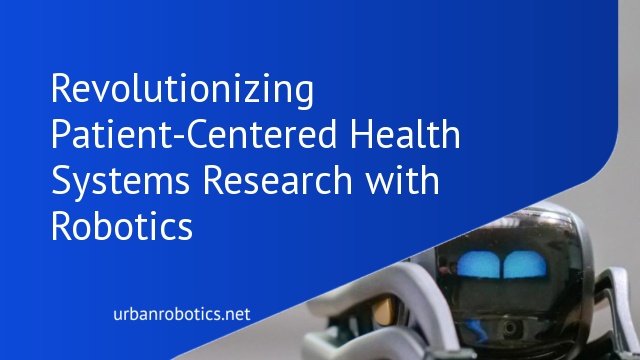Understanding Patient-centered Health Systems Research
Patient-centered health systems research focuses on designing, evaluating, and refining healthcare systems with the patient’s perspective as the cornerstone. By prioritizing patient needs, preferences, and values, this research aims to create systems that enhance patient satisfaction, safety, and outcomes. We emphasize the importance of understanding patient experiences through qualitative and quantitative methods, such as surveys and interviews, to gather comprehensive insights.
Effective patient-centered research involves collaboration among healthcare providers, patients, and researchers. By integrating patient feedback into system design, healthcare services can become more responsive and adaptive to individual patient needs. Analyzing large datasets helps identify patterns and trends in patient experiences, which can inform continuous improvement efforts.
Advancements in health technology, including robotics, provide innovative tools for patient-centered research. Robotic systems can automate routine tasks, reduce errors, and offer real-time data collection. This automation gives healthcare professionals more time to focus on direct patient care, ultimately improving the healthcare experience.
Integrating Robotics in Health Systems
Integrating robotics in health systems introduces innovations that enhance efficiency and patient care. These advancements offer substantial potential for optimizing healthcare operations and delivery.
Types of Robotics Used
Different types of robotics focus on various healthcare aspects. Surgical robots enhance precision in surgeries, offering minimally invasive options. Rehabilitation robots support patient recovery through targeted therapy. Diagnostic robots assist in identifying conditions, using advanced imaging and data analysis. Logistic robots streamline hospital operations by managing supplies and medication delivery. Together, these robots improve patient outcomes and healthcare efficiency.
Benefits of Robotics in Healthcare
Robotics in healthcare provides numerous benefits. Increased precision in surgical procedures reduces recovery times and minimizes complications. Automated tasks, handled by logistic robots, alleviate staffing pressures and optimize resource management. Diagnostic robots accelerate disease detection, leading to timely treatment. Rehabilitation robots offer personalized therapy, resulting in improved patient recovery outcomes. These benefits highlight the transformative potential of robotics in healthcare systems.
Key Research Areas in Robotics and Patient Care
Improving Patient Outcomes
Robotics in healthcare focuses on using advanced technologies to improve patient outcomes. Surgical robots, for example, provide increased precision in procedures, reducing recovery times and complications. Rehabilitation robots offer personalized therapy that adapts to individual patient needs, accelerating recovery. Diagnostic robots help in early disease detection and accurate diagnoses, enhancing treatment effectiveness. Studies have shown that these innovations lead to higher patient satisfaction and better long-term health results. We integrate these robotic solutions to benchmark patient-centered care and promote overall well-being.
Enhancing Healthcare Efficiency
Robotics play a crucial role in enhancing healthcare efficiency by streamlining various operations. Logistic robots ensure the timely delivery of medications and supplies within healthcare facilities, reducing human error. Automated systems improve scheduling and patient flow management, decreasing waiting times. Telepresence robots enable remote consultations, making healthcare access wider and more immediate. By implementing these robotic technologies, we can optimize resource management, cut operational costs, and focus more on direct patient care, ensuring healthcare systems run smoothly and effectively.
Case Studies of Robotics in Patient-centered Research
Examining real-world applications of robotics reveals critical insights into patient-centered research. These case studies highlight notable successes and challenges in integrating robotics into healthcare systems.
Successful Implementations
Robotics have significantly improved patient outcomes in various healthcare settings. At Mayo Clinic, surgical robots enable precision in minimally invasive procedures, leading to faster recovery times. Rehabilitation robots at Shirley Ryan AbilityLab provide customized therapy, enhancing patient mobility. Diagnostic robots at Cleveland Clinic achieve early disease detection, resulting in timely interventions. These implementations have demonstrated heightened patient satisfaction and better health outcomes.
Challenges and Lessons Learned
Though successful, integrating robotics into patient-centered research isn’t without challenges. High initial costs and maintenance can be prohibitive for smaller institutions. At Boston Medical Center, technical issues with robotic systems highlighted the need for rigorous training and support. Privacy concerns emerged at Stanford Health due to data sensitivity in automated diagnostic processes. These lessons emphasize balancing innovation with practical and ethical considerations in patient care.
Future Prospects and Innovations
Robotics in patient-centered health systems research is progressing rapidly. We’re seeing significant advancements and exploring the potential impacts on healthcare.
Emerging Technologies
Several emerging technologies in robotics show promise for transforming healthcare systems. Autonomous mobile robots aid in hospital logistics by delivering supplies, reducing staff workload. Wearable robots, like exoskeletons, offer advanced mobility assistance for patients with disabilities. AI-driven diagnostic tools improve accuracy in disease detection and treatment planning. These technologies, supported by ongoing research, are set to enhance patient care significantly.
Potential Impact on Healthcare
The integration of these innovations has the potential to revolutionize healthcare delivery. Enhanced precision in surgical procedures reduces recovery time and complications. Rehabilitation robots enable personalized therapy, accelerating patient recovery. AI diagnostic tools permit early disease detection, leading to better prognosis and treatment outcomes. By adopting these technologies, healthcare systems can provide more efficient, effective, and patient-centered care, ultimately improving patient satisfaction and reducing overall healthcare costs.
Conclusion
As we embrace the future of healthcare, patient-centered health systems research with robotics stands at the forefront of innovation. By focusing on patient needs and leveraging advanced technologies, we’re paving the way for more precise, personalized, and efficient care. The integration of surgical, rehabilitation, and diagnostic robots showcases the tremendous potential to enhance patient outcomes and satisfaction. Emerging technologies like autonomous mobile robots and AI-driven diagnostic tools promise to further revolutionize the field. Our commitment to patient-centered approaches ensures that these advancements will continue to transform healthcare delivery, making it more effective and accessible for everyone.





